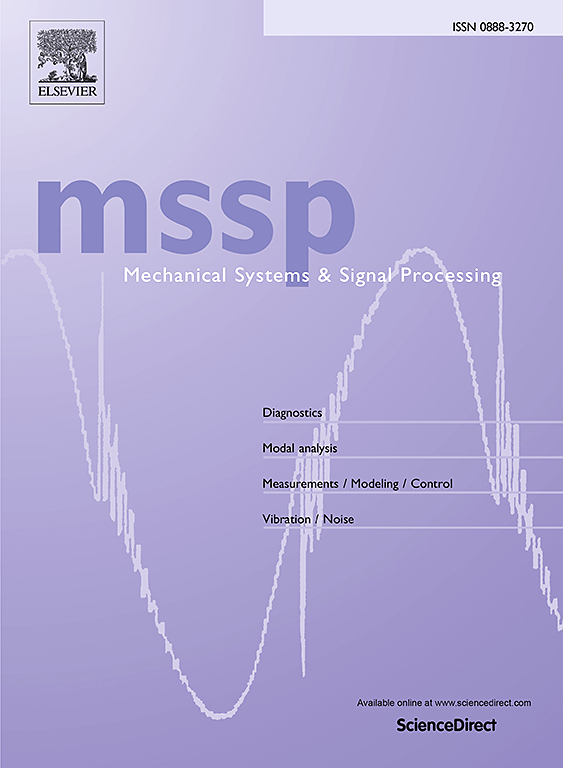DTFFNet: A dual-branch time–frequency feature fusion network for remaining useful life prediction of mechanical equipment
IF 7.9
1区 工程技术
Q1 ENGINEERING, MECHANICAL
引用次数: 0
Abstract
With its exceptional feature extraction and modeling capabilities, deep learning has emerged as a cornerstone technology in the field of remaining useful life (RUL) prediction for mechanical equipment. However, time-domain-based deep learning methods face significant limitations in capturing global features, hindering their ability to fully model the complexities of equipment degradation processes. To address these challenges, we propose DTFFNet, a dual-branch time–frequency interactive integration framework that combines time-domain and frequency-domain signal analysis for efficient feature interaction and fusion. Specifically, the time-domain branch employs a CNN-Transformer structure to extract local features and model long-term dependencies within sequences. The frequency-domain branch utilizes a frequency-domain Multilayer Perceptron (MLP) to extract global dependencies from the real and imaginary components of Fourier-transformed signals. Additionally, a multi-head cross-attention mechanism is introduced to construct a time–frequency cross-domain interactive fusion module, enabling information exchange and complementary representation learning across time and frequency domains, enhancing feature fusion depth and effectiveness. To meet the specific demands of RUL prediction, a joint learning strategy is proposed that combines weighted and constrained MSE losses, enabling targeted optimization during critical degradation phases and along specific error directions to enhance prediction accuracy. Finally, experimental analysis on widely used turbofan engine dataset and PHM 2012 bearing dataset demonstrates that DTFFNet not only significantly improves prediction accuracy compared to mainstream RUL prediction methods but also exhibits enhanced robustness in noisy environments. These results establish DTFFNet as a reliable and effective solution for equipment health management in complex industrial settings.
DTFFNet:用于机械设备剩余使用寿命预测的双支路时频特征融合网络
凭借其卓越的特征提取和建模能力,深度学习已成为机械设备剩余使用寿命(RUL)预测领域的基石技术。然而,基于时域的深度学习方法在捕获全局特征方面面临重大限制,阻碍了它们对设备退化过程的复杂性进行全面建模的能力。为了解决这些挑战,我们提出了DTFFNet,这是一个双分支时频交互集成框架,将时域和频域信号分析相结合,以实现有效的特征交互和融合。具体而言,时域分支采用CNN-Transformer结构提取局部特征并对序列中的长期依赖关系进行建模。频域分支利用频域多层感知器(MLP)从傅里叶变换信号的实分量和虚分量中提取全局依赖关系。此外,引入多头交叉注意机制构建时频跨域交互融合模块,实现跨时频域信息交换和互补表示学习,增强特征融合深度和有效性。为了满足RUL预测的具体需求,提出了一种结合加权和约束MSE损失的联合学习策略,在关键退化阶段和特定误差方向进行有针对性的优化,以提高预测精度。最后,对广泛使用的涡扇发动机数据集和PHM 2012轴承数据集的实验分析表明,与主流RUL预测方法相比,DTFFNet不仅显著提高了预测精度,而且在噪声环境下表现出更强的鲁棒性。这些结果确立了DTFFNet作为复杂工业环境中设备健康管理的可靠和有效的解决方案。
本文章由计算机程序翻译,如有差异,请以英文原文为准。
求助全文
约1分钟内获得全文
求助全文
来源期刊

Mechanical Systems and Signal Processing
工程技术-工程:机械
CiteScore
14.80
自引率
13.10%
发文量
1183
审稿时长
5.4 months
期刊介绍:
Journal Name: Mechanical Systems and Signal Processing (MSSP)
Interdisciplinary Focus:
Mechanical, Aerospace, and Civil Engineering
Purpose:Reporting scientific advancements of the highest quality
Arising from new techniques in sensing, instrumentation, signal processing, modelling, and control of dynamic systems
 求助内容:
求助内容: 应助结果提醒方式:
应助结果提醒方式:


